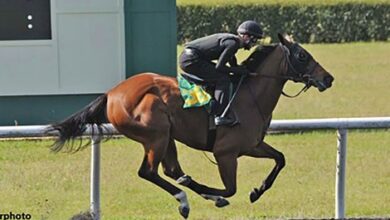Three Years After Arrests, Racing Plots Path Forward

In the 1995 movie “Apollo 13” there’s a memorable scene in which a NASA official details all of the problems facing the damaged spacecraft and the dangers for the astronauts inside it and says the mission will likely be a tragic failure.
“This could be the worst disaster NASA has ever experienced,” he said.
In response, with a staunch belief that the astronauts will return home safely, the flight director replied, “In all due respect, sir, I believe this is going to be our finest hour.”
In the future, perhaps 10 or 15 years from now, the strength of the horse racing industry may be judged by the ability to speak in an equally positive tone about the steps taken following the events of March 9, 2020.
Three years ago, Thoroughbred and Standardbred racing had a day of infamy. Twenty-seven individuals—horsemen, veterinarians, and drug/substance manufacturers—were indicted on federal charges of race doping and distributing adulterated and misbranded medications. In Thoroughbred racing, trainers Jorge Navarro and Jason Servis, who combined for more than 2,600 starts with 778 wins and earnings of nearly $40 million from 2018-2020, were the most notable names.
It was a dark day that gave credence to a concern the industry had pushed back against for decades: Horse racing was rife with corrupt individuals, and its horses were overmedicated and put at risk to win races.
“On the day of the indictments I thought we were on the dawn of a new era, and this was either going to be good, or it was really going to be bad,” said Jim Gagliano, president and COO of The Jockey Club, which along with Meadowlands Racetrack played a key role in the indictments by bringing in 5 Stones Intelligence for the early undercover work that led to the involvement of federal enforcement officials.
In the years since the court cases are nearing an end with a virtual clean sweep for federal prosecutors. From an expanded list of 30 defendants, 21 have already been sentenced to federal prison terms, three others have been convicted and await sentencing, and two others were convicted and had sentencing deferred. Four are no longer under indictment.
Yet aside from the stark lessons in the severe penalties the cheaters face, many in the industry view the indictments as the impetus for meaningful ongoing change. In particular, it brought in additional support of the Horseracing Integrity and Safety Act, which would see the Horseracing Integrity and Safety Authority oversee national safety and medication standards. The legislation launching the Authority received Congressional approval and was signed into law in December 2020 as part of a larger bill.
“It was a wake-up call. At the time of the indictments, we still did not have some of the leading people, politicians, and organizations on board. Churchill Downs had not made a commitment, and from their very good input and involvement, some good changes were made,” Gagliano said. “In time, we have come to see the indictments as something positive. It showed what concerted enforcement can bring to the sport.”
Dennis Drazin, CEO and chairman of Darby Development which operates Monmouth Park, also views the indictments as a turning point in support for HISA and national standards.
“There would be no HISA without the indictments,” he said. “It had been kicking around in a number of different forms for a few years, but perceptions changed after the indictments.”
The indictments lifted a veil of secrecy over illegal activities. Wiretap evidence revealed conversations in which drug suppliers pedaled to trainers banned substances such as SGF-1000, which contains growth factors, or new, illegal designer drugs given to corrupt veterinarians. They, in turn, administered the drugs and, in many cases, falsely billed owners.
“There were suspicions about activities and how people might execute doping through suppliers and how it ends up in the hands of trainers and vets. We learned a lot about what was happening from the good work that the government put in, both prosecutors and the FBI,” Gagliano said. “We also learned how difficult it is to catch cheaters and the tools that the prosecutors and the FBI had were enormous, especially in terms of electronic surveillance. And we learned that there’s still a lot out there that we don’t have great visibility into, which shows why we need HISA.”
The charges filed by the government also showed inadequacies in state-to-state regulation of the sport. While there was a 2019 notice on a New York Racing Association overnight sheet warning horsemen not to use SGF-1000, Navarro and Servis’ horses did not test positive for the substance, tying the hands of regulators.
The introduction of federal authorities changed the landscape. Some might debate the impact of SGF-1000, and people close to defendants initially believed they would be found innocent at trial if their lawyers could confuse jurors about the ingredients and benefits of the drugs. But in the end, the defendants’ own words convicted them.
The most damning evidence in the cases came through court-approved wiretaps in which the defendants talked about using illegal drugs, how they were undetectable, how they misbranded them, how they made horses run better. The defendants admitted in conversations that they were breaking federal law, trumping the role of the drugs’ impact on the horses in the eyes of the court.
In one taped 2019 conversation, veterinarian and drug manufacturer Dr. Seth Fishman, convicted and facing 11 years in prison, said to an unidentified person, “Any time you give something to a horse, that’s doping.” He added, “Whether or not they test for it is another story.”
Other taped conversations included a statements from sentenced conspirators Nick Surick to Michael Tannuzzo, like, “You know how many (expletive) horses (Navarro) (expletive) killed and broke down that I made disappear? You know how much trouble he could get in if they found out (about) the six horses we killed?”
Servis said in another conversation, “The horses are running like crazy.”
It proved to be an iron-clad case in which only two defendants—Fishman and his employee Lisa Giannelli—denied their guilt long enough to stand trial. Both were convicted.
“When you have a case that strong, it’s not unusual for the government to get results like that,” said Drazin, a practicing attorney who led the court challenge that opened the door for sports betting nationwide.
To date, 30 individuals have received a total of 684 months, or 57 years, in prison time. Navarro received five years, with deportation to follow afterward. Servis, who is 65, has yet to be sentenced but is facing the likelihood of a five-year sentence.
The case has also generated $104,609,320.20 in fines, restitution, and forfeitures. While the government will most likely collect the $433,912 it is owed in fines and much of the $32.4 million listed in forfeitures, restitution falls into a different category. In general, forfeitures are based on a convict’s assets, such as property, that can be seized by the government. The biggest forfeiture was $13.5 million from Fishman, while the lowest was trainer Tannuzzo’s $15,893.
Restitution in this case centers on purse money accrued by the trainers as illustrated by levies of $42.7 million on harness trainer Surick and $25.8 million on Navarro. Since trainers typically receive about 10% of winning purses, those totals are far beyond the trainers’ means of repaying and probably will not be paid.
Early in the case, prosecutors mentioned redistribution of purse money as a possible form of restitution but no action has been taken on that front, and it is unlikely to happen since the trainers’ Thoroughbreds did not fail drug tests and the process of determining which horses were drugged for which race could take decades to resolve.
“This represented the biggest sports corruption case in the history of America. I can’t think of any bigger one in terms of successful prosecutions and time served,” Gagliano said. “It was a very big deal for the government to undertake.”
With the final sentences expected to be handed down by the summer, the book will be closed on the case. As the sport moves forward, history will ultimately frame whether the convictions were the spark for meaningful reform or just one more ugly moment in a perpetual game of cat-and-mouse between cheaters and regulatory bodies.
While there was conjecture that there would be a second round of indictments, the government now seems unwilling to present a new case, likely to be viewed with a sigh of relief by any other dopers and cheaters.
It is fair to reason that during the cheating, those involved may have figured that if caught, they would face the typical racetrack penalty of a suspension and/or fine. Instead, because of the federal charges, they received prison time, fines, and legal bills that drained them financially. The arrests no doubt registered some initial fear among others who administered or were involved with similar drugs that the FBI would be knocking on their door.
But now the onus rests squarely on the industry and HISA to grab the baton from the government and take the vigorous steps necessary to combat cheating in the sport.
“We’ve learned that the government will not continue to do this and be the enforcement arm of Thoroughbred racing. So it has never been more important to establish HISA, which will provide enforcement across state borders, something we’ve never had,” Gagliano said. “I came away from attending all of the trials feeling it was the inadequacies we had by enforcement on a state-by-state basis that the cheaters took advantage of. While HISA’s anti-doping and medication control program will not take the field until March 27, it will give us a tremendous advantage in enforcing drug and safety rules.”
Given the vital importance of combating doping and PED use, the pressure on HISA to live up to its lofty expectations is already enormous. The indictments revealed that post-race drug testing is not a cure-all for the problem. It must constantly advance and evolve methodology to handle the next “undetectable” drug. HISA is committed to combining testing efforts with investigations.
The wiretaps that led to the convictions are likely not in play as a tool like they were four years ago. While in some states permission to tape a conversation requires the approval of just one party, allowing an informant to record crucial evidence, the ability to tap telephone lines and calls between two unsuspecting parties can only happen with a court order requested by a government agency.
“We’re trying to stop the cheating, but people have to realize the racetrack doesn’t do the drug test. We rely on the racing commissions to do the drug testing and catch the cheaters. We’re not allowed to do the tests. The fact that all the tests were clean for SGF-1000 is problematic,” Drazin said. “We need to make the out-of-competition testing and investigations more effective. Without the government, someone has to handle the enforcement better.”
While the indictments ultimately ensnared 30 people, a key takeaway for some observers is whether investigators dug deep enough and what will happen with reams of evidence in the case involving people who were not charged. Will the files be sealed once the final case is settled, or will they be released and redacted names in court documents revealed?
“I’m somewhat disappointed they went after a small group of people when the industry knows SGF-1000 was very prevalent around the country. I thought eventually the information would come out,” Drazin said. “I’m sure the U.S. attorneys gathered all of the information on which trainers were getting the medication. They knew which vets were giving the medication and it should be clear to everyone that when New York put it on an overnight entry sheet, warning people not to use it, there was widespread use of it.
“It gave clarity that it was illegal to use it, but a lot of trainers and vets continued to use it. I’d like the information to be released publicly at some point. If someone was using it and cheating, I don’t think they should be able to walk away and have no penalties.”
Yet as much as HISA figures to play the crucial role in racing’s fight against cheaters, much will also depend on how well racetracks and horsemen learn from what happened three years ago. In years to come, will horsemen who spoke out about constantly losing to Navarro and Servis but did not assist regulators become more vigilant about cheating and work with enforcement officials to maintain a level playing field?
Also, racetracks have to learn from what was detailed on tapes and court documents and be more active in policing the corrupt horsemen on their backstretch, a point Drazin understands all too well. Not only was Navarro the leading trainer at Monmouth Park for seven straight years, but Servis trained some of Drazin’s horses.
“I certainly learned a lot from all of this. In the 30 years that I knew Jason, I thought he was as honest as could be and I was very, very shocked to read about the indictments. I still have some issues with some of the information out there,” he said. “It makes you less trusting and teaches you to pay more attention. Yet assuming that the government’s scenario is right that there were phony bills, that is very concerning to me. I didn’t get bills for SGF-1000 and it wasn’t just Jason buying it. The vets were injecting it, and should they still be at the racetrack if they falsified records?
“I think better testing and investigations will cut down on cheating,” he added, “but there are still bad actors who want to cheat and are still going to try to figure out a way to do it. I hope they catch every cheater that’s out there.”




